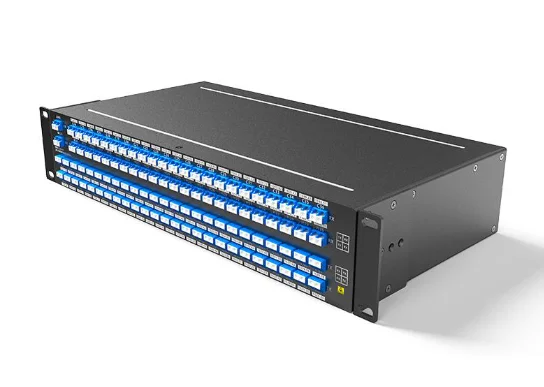- This topic is empty.
-
AuthorPosts
-
28/04/2025 at 23:15 #3717
In the ever-evolving field of optical communication, the efficient management of data traffic is crucial to ensure high performance and scalability. One of the most effective tools in achieving this is the passive WDM mux demux (Wavelength Division Multiplexer/Demultiplexer), which plays a pivotal role in increasing network capacity and ensuring seamless data transmission across modern communication systems. As optical networks continue to expand, the demand for more bandwidth is ever-growing, and the passive WDM mux demux is at the heart of the solution. This article WDMLight explores the applications of passive WDM mux demux in optical communication networks.
What is a Passive WDM Mux Demux?

A passive WDM mux demux is a device used in optical communication systems to combine (mux) or split (demux) multiple optical signals at different wavelengths, allowing for the transmission of multiple signals through a single optical fiber. The "passive" aspect refers to the fact that the device does not require any external power source to operate, making it both energy-efficient and cost-effective. It works by utilizing optical interference and diffraction techniques to separate or combine the wavelengths of light.
In a typical setup, a passive WDM mux demux combines multiple signals, each on a separate wavelength, into a single optical fiber for transmission. At the receiving end, the demux splits the combined signal back into its constituent wavelengths, each carrying a different data stream. This process is vital for the efficient use of fiber optic infrastructure, as it increases the overall data transmission capacity without requiring additional fiber optic cables.
These devices are essential in dense wavelength division multiplexing (DWDM) systems, where high-capacity networks require the transmission of numerous data channels simultaneously, each on a distinct wavelength. Passive WDM mux demux units provide a simple, reliable solution for the multiplexing and demultiplexing of optical signals in these systems.
Applications of Passive WDM Mux Demux
The passive WDM mux demux has a wide range of applications in various industries, particularly in telecommunications, data centers, and broadband networks. Below are some of the most significant areas where these devices are utilized:
1. Telecommunications Networks
Telecommunications networks rely on efficient data transmission across vast distances, often involving the need to transport high volumes of data. Passive WDM mux demux devices enable network operators to maximize the use of their fiber optic infrastructure by transmitting multiple channels of data simultaneously on different wavelengths. In large-scale telecommunications systems, passive WDM mux demux devices facilitate the growth of bandwidth by enabling the efficient multiplexing and demultiplexing of optical signals. As network traffic increases and demand for higher bandwidth rises, the ability to transmit multiple channels on a single fiber allows for a significant increase in network capacity without requiring additional fiber optic cables.
2. Data Centers
Data centers, which host and manage vast amounts of data, benefit greatly from the high-capacity capabilities of passive WDM mux demux units. As data traffic continues to grow, there is an increasing need for efficient ways to manage and transmit large volumes of data between servers, storage devices, and other network equipment. By employing passive WDM mux demux devices, data centers can optimize their fiber optic connections, allowing for the simultaneous transmission of multiple data streams over a single fiber. This reduces the need for additional infrastructure and enhances the overall performance of the data center.
3. Long-Haul Networks
Long-haul optical networks, which span large geographic areas and carry substantial amounts of data, rely heavily on the efficiency of wavelength division multiplexing. The passive WDM mux demux is a critical component in these networks, as it enables the combination and separation of signals traveling over long distances. In long-haul networks, passive WDM mux demux units are used to efficiently manage data transmission, reducing the need for signal regeneration and amplification, which are typically required in active systems. The passive nature of the device makes it ideal for use in remote locations where power resources may be limited.
4. Metro Networks
Metro networks, which provide high-speed internet and data services within urban areas, can greatly benefit from the use of passive WDM mux demux devices. These devices enable service providers to offer increased bandwidth to customers by efficiently utilizing existing fiber infrastructure. By employing passive WDM mux demux, metro networks can support higher data rates, enhance the overall user experience, and reduce the cost of network expansion. This is especially important as urban populations grow, and demand for high-speed data services continues to rise.
5. Cable Television Networks
Cable television networks that deliver content to homes and businesses rely on the efficient use of their fiber optic infrastructure. Passive WDM mux demux devices allow for the simultaneous transmission of multiple channels of television programming, as well as data services, over a single fiber. By enabling wavelength multiplexing, cable operators can increase the capacity of their networks, offering more channels and services without the need for additional fiber cables. This results in cost savings and improved service delivery.
The passive WDM mux demux is a crucial component in modern optical communication systems, offering significant advantages in terms of cost, energy efficiency, scalability, and reliability. By enabling the multiplexing and demultiplexing of optical signals on different wavelengths, it allows for the efficient use of fiber optic infrastructure, enhancing network capacity and performance. Whether in telecommunications networks, data centers, long-haul connections, or metro networks, the passive WDM mux demux plays an essential role in ensuring high-bandwidth data transmission. As the demand for faster, more reliable communication continues to grow, the use of these devices will become increasingly important in meeting the needs of modern optical communication systems.
https://www.wdmlight.com/CWDM-dwdm-Components
http://www.wdmlight.com
WDMLight -
AuthorPosts
- You must be logged in to reply to this topic.